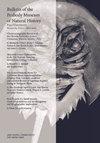马拉湖慈鲷属Otopharynx的六个新种(Teleostei:慈鲷科)
IF 0.9
4区 哲学
Q2 BIODIVERSITY CONSERVATION
引用次数: 3
摘要
摘要马拉湖特有慈鲷属Otopharynx从14种增加到20种,通过描述从近海沙质或中等岩石/沙质地区采集或在59米深处拖网捕鱼的6个新物种,以及它独特的咽骨形状和许多小而拥挤的牙齿。被认为是孟买岛的特有种,通过一个完全位于上侧线下方的胸上斑点与大多数同类动物分开,并通过13个鳃耙的组合与所有其他同类动物分开。咽骨后缘几乎笔直,中柱中所有咽齿的牙冠变宽变平,头部长度30.9–32.2%SL,体深35.5–36.1%SL和下颚35.7–36.2%HL。Otopharynx styrax的身体比任何同类都更细长(深度24.3–28.6%SL)。可以通过与上侧线重叠的胸上斑点、背鳍基部下方的七或八个垂直条、10或11个鳃耙、侧线中的34-36个鳞片、具有蜕皮状后内侧牙齿的下咽骨和其深度的1.6-2.0倍的尾柄长度的组合来诊断耳咽畸形。鼻咽脂膜炎的诊断是由一个突出的方形胸上斑点横跨3至4个跖骨下条,没有背中线斑点,13-15个鳃耙,侧线有31-33个鳞片,15或16个背鳍棘,没有泪道切口,下咽骨中柱的牙齿轻微增大。Otopharynx pipidekamost与O.paniculus非常相似,并有泪腺切迹的缺失,但侧线有34-35个鳞片和11-13个鳃耙。提供了五个新物种的活体或新采集标本的照片。本文章由计算机程序翻译,如有差异,请以英文原文为准。
Six New Species of the Cichlid Genus Otopharynx from Lake Malaŵi (Teleostei: Cichlidae)
Abstract The endemic Lake Malaŵi cichlid genus Otopharynx is increased from 14 species to 20 by the description of six new species collected from inshore sandy or intermediate rocky/sandy areas or trawled in depths to 59 m. Otopharynx alpha is distinguished from congeners by its unique melanin pattern with suprapectoral spot discrete but supraanal and precaudal spots connected to form a stripe, and by its distinctively shaped pharyngeal bone with numerous small, crowded teeth. Otopharynx mumboensis, thought to be endemic to Mumbo Island, is separated from most congeners by a suprapectoral spot placed entirely below the upper lateral line, and from all others by the combination of 13 gill rakers, pharyngeal bone with posterior margin nearly straight, crowns of all pharyngeal teeth in the median columns broadened and flattened, head length 30.9–32.2% SL, body depth 35.5–36.1% SL, and lower jaw 35.7–36.2% HL. Otopharynx styrax has a more elongate body (depth 24.3–28.6% SL) than any congener. Otopharynx aletes can be diagnosed by the combination of a suprapectoral spot overlapping the upper lateral line, seven or eight vertical bars below the dorsal-fin base, 10 or 11 gill rakers, 34–36 scales in the lateral line, lower pharyngeal bone with molariform posteromedian teeth, and caudal peduncle length 1.6–2.0 times its depth. Otopharynx panniculus is diagnosed by the combination of a prominent square suprapectoral spot spanning subdorsal bars 3 to 4, no dorsal midline spots, 13–15 gill rakers, 31–33 scales in the lateral line, 15 or 16 dorsal-fin spines, absence of a lacrimal notch, and slightly enlarged teeth in the median columns of the lower pharyngeal bone. Otopharynx peridodekamost closely resembles O. panniculus and shares the loss of the lacrimal notch, but has 34–35 scales in the lateral line and 11–13 gill rakers. Photographs of living or freshly collected specimens of five of the new species are provided.
求助全文
通过发布文献求助,成功后即可免费获取论文全文。
去求助
来源期刊

Bulletin of the Peabody Museum of Natural History
BIODIVERSITY CONSERVATION-ECOLOGY
CiteScore
2.40
自引率
0.00%
发文量
6
审稿时长
>12 weeks
期刊介绍:
The Bulletin of the Peabody Museum of Natural History publishes original research based on specimens, artifacts and related materials maintained in the collections of the Yale Peabody Museum of Natural History’s curatorial divisions. The Bulletin is published twice a year, in April and October.
 求助内容:
求助内容: 应助结果提醒方式:
应助结果提醒方式:


